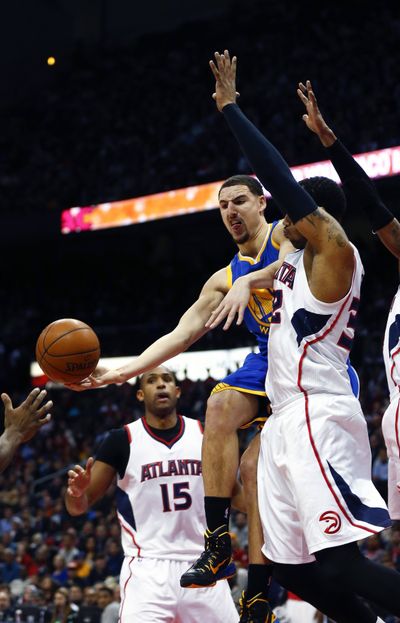Commentary: Warriors, Hawks big part of NBA’s new golden era

ATLANTA – The San Antonio Spurs showed the way.
Yes, a true team can beat a handful of superstars.
Now, the Atlanta Hawks and the Golden State Warriors are following the same path with stunning results, signaling a change in the league’s power structure and, from all indications, a new golden age in the NBA.
Certainly, the game is as good as it’s ever been.
And, as more teams follow this inevitable trend toward a style built on ball movement and getting everyone involved, it’s only going to get better.
“It’s how you want to play. It’s how the game of basketball should be played,” Atlanta All-Star forward Paul Millsap said Friday before a highly anticipated matchup against the Warriors that the Hawks won 124-116. “It looks better. It’s fun. Guys enjoy it.”
It’s certainly paying huge dividends in Atlanta, where a perennially middle-of-the-road (or worse) franchise has suddenly become the talk of the NBA. The Hawks are coming off a 19-game winning streak and hold a commanding lead in the Eastern Conference – without anyone averaging close to 20 points a game.
The West-leading Warriors aren’t quite as diverse, with nearly 46 percent of their scoring hoarded by “Splash Brothers” Stephen Curry and Klay Thompson. Still, they play a San Antonio brand of hoops, with three other players averaging in double figures and a deep bench.
Curry and Thompson are their biggest outside threats, to be sure, but five of their teammates have attempted at least 50 3-pointers, demonstrating Golden State’s commitment to always finding the open man and having confidence that, whoever that is, he’ll hit the shot.
“It’s beautiful to watch,” Golden State coach Steve Kerr said.
While the Spurs have been relying on this team-first philosophy for years with great success, many stuck to the idea that a team had no chance of winning a title if it didn’t have one or two of the league’s best players.
Then came last year’s NBA Finals.
Miami had the best player on the planet, LeBron James, and two pretty good sidekicks, Chris Bosh and Dwyane Wade. The Spurs countered with a team in every sense of the word; no one averaged more than 16.7 points during the regular season, but six players were in double figures.
The outcome was astonishing. San Antonio romped to the championship in a five-game blowout, its four victories by an average of 18 points.
While Kawhi Leonard is remembered as the breakout star from that series, it was pretty much business as usual for the Spurs. Tony Parker (18.0) was the team’s top scorer – more than 10 points a game less than James’ average – and five other players averaged at least 9.2.
“The trend a couple of years ago was loading up to one side of the floor, stopping the iso (isolation play),” Hawks guard Kyle Korver said. “A lot of teams kind of caught on to that. Then you see some of the success the Spurs had, some of these teams that get good players to buy into team basketball. When you do that, it’s really hard to guard.”
In Atlanta, the Hawks hired longtime Spurs assistant Mike Budenholzer before last season, hoping he could instill the same concepts that worked so well for Gregg Popovich in San Antonio. General manager Danny Ferry knew he didn’t have a superstar, so he constructed the roster with the idea of having a bunch of guys capable of hitting the outside shot, from the point guard to the center.
It has worked better than anyone could’ve imagined.
By spreading the floor, the Hawks turn opponents into something resembling a rubber band, stretched thin until it finally breaks. Atlanta will shoot from pretty much anywhere, which almost makes it seems like they’ve slipped an extra player or two on the court.
The Warriors play much the same way, taking full advantage of NBA rule changes over the last few years that have opened up the offensive flow, allowed players to move unencumbered around the court, and pretty much eliminated the ugly, grinding style once viewed as a key to success.
“The product in the NBA has gotten better – dramatically better – over the last 10 years,” Kerr said. “Some of it is the rules changes. A lot of it is the influence of several coaches.”
For those expecting the next words out of his mouth to be “Gregg Popovich,” Kerr throws a change-up. He points to former Phoenix Suns coach Mike D’Antoni, who shook up the way rosters were constructed after first making a name for himself in Europe, by “playing smaller guys at the 4 who can stretch out the defense, playing a lot of shooters.”
Now, there’s no reason for teams to totally tear themselves down when it’s time to rebuild, hoping to land a top player in the draft or free up enough cap space to pursue the next superstar to become available in free agency.
That will surely make it possible for more teams to compete for championships, as we’re already seeing this year with the improbable rise of Golden State and Atlanta.
“We’re not the Lakers, we’re not New York, we’re not teams that have won championships recently,” Curry said. “It’s kind of fun to switch things up a little bit. I think we’re ready for the moment.”